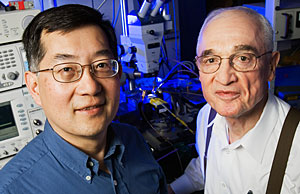CHAMPAIGN, Ill., April 7, 2006 — During stimulated emission tests of a transistor laser, two
University
of
Illinois
engineers were able to coax it to reveal previously unknown fundamental properties, a breakthrough they say will speed commercialization of the device.

University
of
Illinois
professors Milton Feng ( left) and Nick Holonyak Jr. recently coaxed their transistor laser to reveal fundamental properties of both transistors and transistor lasers, moving transistor lasers a step closer to commercialization. (Photo by L. Brian Stauffer)
Illinois
professors Nick Holonyak Jr. and Milton Feng explored the current-voltage relationship in a transistor laser, which was invented by scientists at the university. During stimulated emission, the laser light allowed the scientists to see into the device and study its elusive electronic structure. “We were able to look at the transistor’s operating characteristics, look inside of the transistor and see features and behaviors that we couldn’t see before,” said Holonyak, a John Bardeen Chair Professor of Electrical and Computer Engineering and Physics. “The current-voltage characteristics were clearly distorted under stimulated recombination, compared to ordinary 58-year-old transistor spontaneous recombination.”
The transistor laser employs a quantum well and a resonator in the base to control electron-hole recombination and electrical gain. By blocking the laser resonator with white paste, the researchers converted the device into an ordinary transistor. Because the process is reversible, the researchers could compare collector characteristics when the device was functioning as a normal transistor and when it was functioning as a transistor laser, something that was never before possible.
“We found significant structure in the current-voltage characteristics of the transistor laser, that can be mapped in detail and related to the quantum-well carrier recombination,” said Holonyak. “We were also able to correlate optical measurements with electrical measurements of quantum-well properties.”
The transistor laser combines the functions of both a transistor and a laser by converting electrical input signals into two output signals, one electrical and one optical. Photons for the optical signal are generated when electrons and holes recombine in the base, an intrinsic feature of transistors. “When we weaken the strength of the photon generation process, we change the nature of the process connecting the electron and the hole, and we change their behavior in an electrical sense,” Holonyak said. “When we let the device operate as a transistor laser, however, the photons streaming out let us look inside and see more of the mechanics that goes on. We see features of the transistor never revealed before.”
The change in gain and laser wavelength corresponding to stimulated recombination on quantum-well transitions can be compared to operation in spontaneous recombination and used with conventional transistor charge analysis to determine some of the dynamic properties of the transistor laser.
“This transistor laser is letting us see the properties and mechanics of how fast the electrons and holes generate photons, and we can turn laser photon generation on and off,” said Feng, the Holonyak Chair Professor of Electrical and Computer Engineering. “This allows us to alter the processes and see how the speed and time factors are changing. This is the first time we could directly determine the lifetime, the speed of stimulated recombination. The transistor has now made certain laser measurements easier or more convenient.”
This capability opens the door to developing transistor lasers that operate at different speeds for a variety of commercial applications, Feng said. “Until now, we had missed something important and fundamental about the boundaries of what the photon can do, of what the electron and hole can do, and of what the semiconductor can do,” Holonyak said. “We found those boundaries to be much further out than we had ever imagined, which now makes our prognosis for the transistor laser much more optimistic.”
Feng and Holonyak’s co-authors of the paper that appears in the April 3 issue of the journal Applied Physics Letters are postdoctoral research associates Richard Chan and Gabriel Walter and graduate student Adam James. DARPA funded the work.
For more information, visit: www.news.uiuc.edu